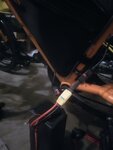Has anyone tried running a Rad City (or other Rad) on a 52v battery? Would the motor and controller be fine with that extra voltage? I really notice on a fresh charge in PAS 3, I see 400 watts after 10 minutes I see 300 w and loose a bar. I am assuming this is just the voltage dropping to the flat part of the discharge curve on the li Ion and the controller is supplying the same amperage but the voltage is sagging a bit.
So could you simply replace the existing 13s pack with a 14s pack (and charger)?
If so does someone make one in the same form factor to make a simple swap?
So could you simply replace the existing 13s pack with a 14s pack (and charger)?
If so does someone make one in the same form factor to make a simple swap?

